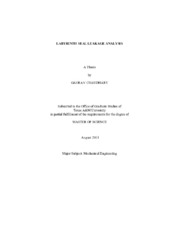Labyrinth Seal Leakage Analysis
| dc.contributor.advisor | Morrison, Gerald | |
| dc.creator | Chaudhary, Gaurav | |
| dc.date.accessioned | 2012-10-19T15:28:43Z | |
| dc.date.accessioned | 2012-10-22T18:05:18Z | |
| dc.date.available | 2012-10-19T15:28:43Z | |
| dc.date.available | 2012-10-22T18:05:18Z | |
| dc.date.created | 2011-08 | |
| dc.date.issued | 2012-10-19 | |
| dc.date.submitted | August 2011 | |
| dc.identifier.uri | https://hdl.handle.net/1969.1/ETD-TAMU-2011-08-9811 | |
| dc.description.abstract | Seals are basic mechanical devices commonly used in machinery to avoid undesired flow losses of working fluids. To understand the working of these seals specifically those placed between relatively moving parts is still one of the major engineering challenges for the scientific community. Particularly Annular seals are one of the most widely used in rotating machinery comprising turbines, compressors and pumps. They are mounted on the shaft that rotates within a stationary case. These seal designs make an impact on (i) machinery energy conversion efficiency and (ii) rotor dynamic stability due to the interaction between rotor and stator through fluid flow leakage. Among all annular seals straight through rectangular labyrinth seals are the most commonly used ones. Their designs have not changed much a lot since its inception by C.J. Parsons [1] back in 1901. These seals provide resistance to the fluid flow through tortuous path comprising of series of cavities and clearances. The sharp tooth converts the pressure energy to the kinetic which is dissipated through turbulence viscosity interaction in the cavity. To understand the accurate amount of leakage the flow is modeled using the discharge coefficient and for each tooth and the kinetic energy carry over coefficients. This research work is aimed at understanding the fluid flow though labyrinth seals with tooth mounted on the rotor. A matrix of fluid flow simulations has been carried out using commercially available CFD software Fluent® where all parameters effecting the flow field has been studied to understand their effect on the coefficients defining the seal losses. Also the rotor surface speed has been used varied in a step by step manner to understand the fluid flow behavior in high speed turbo-machinery. The carry over coefficient is found to be the function of all the geometric elements defining the labyrinth tooth configuration. A relation between the flow parameters and the carry over coefficient has also been established. The discharge coefficient of the first tooth has been found to be lower and varying in a different manner as compared to a tooth from a multiple cavity seal. Its dependence upon flow parameters and dimensionless geometric constants has been established. The discharge coefficient of the first teeth is found to be increasing with increasing tooth width. Further the compressibility factor has been defined to incorporate the deviation of the performance of seals with compressible fluid to that with the incompressible flow. Its dependence upon pressure ratio and shaft speed has also been established. Using all the above the mentioned relations it would be easy decide upon the tooth configuration for a given rotating machinery or understand the behavior of the seal currently in use. | en |
| dc.format.mimetype | application/pdf | |
| dc.language.iso | en_US | |
| dc.subject | Labyrinth Seal | en |
| dc.subject | leakage analysis | en |
| dc.title | Labyrinth Seal Leakage Analysis | en |
| dc.type | Thesis | en |
| thesis.degree.department | Mechanical Engineering | en |
| thesis.degree.discipline | Mechanical Engineering | en |
| thesis.degree.grantor | Texas A&M University | en |
| thesis.degree.name | Master of Science | en |
| thesis.degree.level | Masters | en |
| dc.contributor.committeeMember | Han, J C | |
| dc.contributor.committeeMember | Chen, H C | |
| dc.type.genre | thesis | en |
| dc.type.material | text | en |
Files in this item
This item appears in the following Collection(s)
-
Electronic Theses, Dissertations, and Records of Study (2002– )
Texas A&M University Theses, Dissertations, and Records of Study (2002– )


